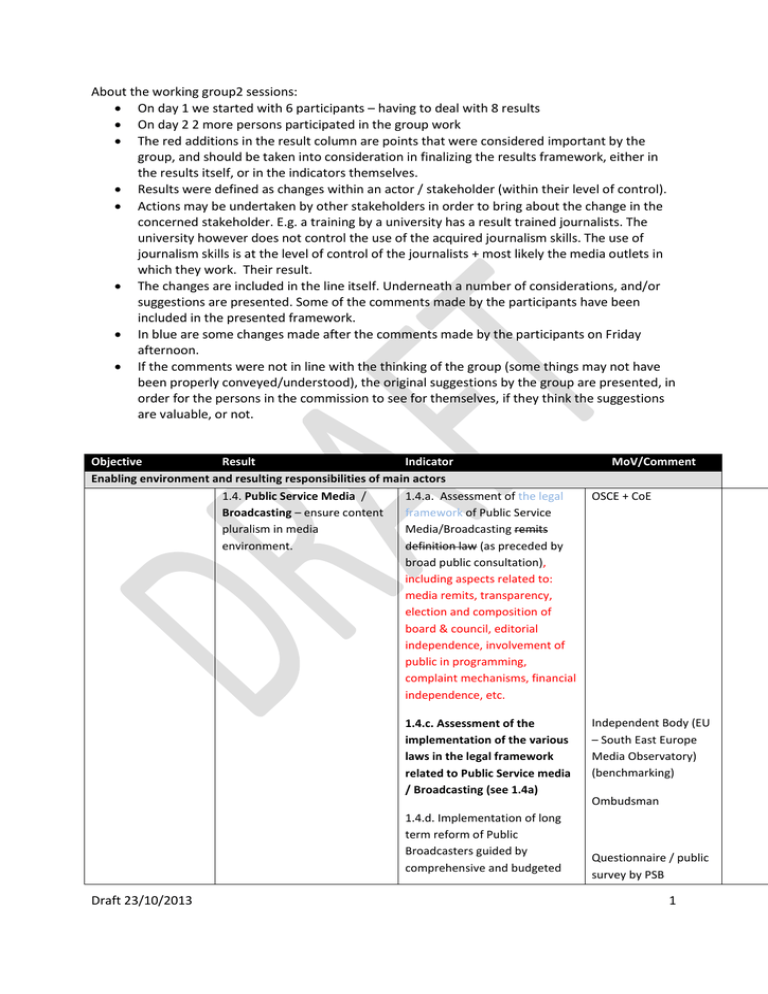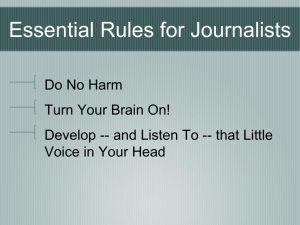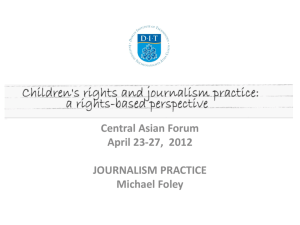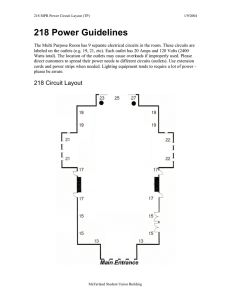Annex F
advertisement

About the working group2 sessions: On day 1 we started with 6 participants – having to deal with 8 results On day 2 2 more persons participated in the group work The red additions in the result column are points that were considered important by the group, and should be taken into consideration in finalizing the results framework, either in the results itself, or in the indicators themselves. Results were defined as changes within an actor / stakeholder (within their level of control). Actions may be undertaken by other stakeholders in order to bring about the change in the concerned stakeholder. E.g. a training by a university has a result trained journalists. The university however does not control the use of the acquired journalism skills. The use of journalism skills is at the level of control of the journalists + most likely the media outlets in which they work. Their result. The changes are included in the line itself. Underneath a number of considerations, and/or suggestions are presented. Some of the comments made by the participants have been included in the presented framework. In blue are some changes made after the comments made by the participants on Friday afternoon. If the comments were not in line with the thinking of the group (some things may not have been properly conveyed/understood), the original suggestions by the group are presented, in order for the persons in the commission to see for themselves, if they think the suggestions are valuable, or not. Objective Result Indicator Enabling environment and resulting responsibilities of main actors 1.4. Public Service Media / 1.4.a. Assessment of the legal Broadcasting – ensure content framework of Public Service pluralism in media Media/Broadcasting remits environment. definition law (as preceded by broad public consultation), including aspects related to: media remits, transparency, election and composition of board & council, editorial independence, involvement of public in programming, complaint mechanisms, financial independence, etc. 1.4.c. Assessment of the implementation of the various laws in the legal framework related to Public Service media / Broadcasting (see 1.4a) 1.4.d. Implementation of long term reform of Public Broadcasters guided by comprehensive and budgeted Draft 23/10/2013 MoV/Comment OSCE + CoE Independent Body (EU – South East Europe Media Observatory) (benchmarking) Ombudsman Questionnaire / public survey by PSB 1 strategies (matching the PS remit). (outsourcing to professional agencies) 1.4.e. Sustainability and autonomy of PSB financing mechanism. 1.4.h. measuring dynamics of public’s trust in PSB. 1.4.i. level of completion of the digitalisation efforts Observations / Suggestions in relation to 1.4 Result 1.4 includes result aspects that have to do with the enabling environment (controlled by other govt. Institutions) as well as with results that are controlled by the public service media themselves. Examples: Indicator 1.4a, 1.4b and 1.4c (and 1.4e?) seem to focus on the enabling environment (legal framework), 1.4 d (enabling enviroment if reform is ”owned by others”, PBS if implemented by PBS themselves?). 1.4f As well as 1.4g are clearly controlled by the public service media themselves. Suggestion of the group was to split the indicators into two types of change, which can then be developed into two composed indicators): o Assessment of the law that regulates the functioning of the public service media – or PSB (enabling environment result of concerned goverment institutions). Harmonsded with international standards – CoE and Amsterdam ??) o Assessment of the implementation of the law (result by public service media institution) and other results that can be seen as change in the functioning of PBS. These last results may be presented under component 2 – modern level of internal governance (all media: PBS + Media Outlets) The assessment of the law should be done by OSCE and council of europe (in order to have an independent assessment – with a certain political clout) To assess to which extent the law is actually implemented may be done by the South Eastern Europé Media Observatory, (this would be a kind of watchdog function) 1.4d is the reform implemented by the media themselves (result of media), or by the government (enabling environment) The assessment of the law should focus on a number of issues (to be further finetuned maybe) o Public service media remits o Editorial independence o Financing mechanism and sustainability (possibilities to generate funds) o Transparency in relation to ownership and funding of the public service media o Transparency in relation to publishing of of annual (including financial) reports o The election process of the board / council of public media o The involvement of the public in programming (as a means to guarantee the public character of the ownership of the programming – e.g. are minority groups served by public media). o Complaints procedures The implementation of the legal framework should cover the same issues. Draft 23/10/2013 2 Additional indicator of public trust is good, as well as the level of completion of the digitalisation efforts (shows if change is taking place). There is no real indicator relating to content pluralism! Indicator 1.4e should be the outcome of all results. Results from a) the sphere of enabling environment, and b) results in terms of changes in operations of public service media should contribute to this together. PSM/PBS that are financially sustainable and autonomous. Advancing media to a modern level of internal governance 2. Improved 2.1. Media outlets adhere to standards and principles of good governance. accountability in media sector. Growing public’s confidence in media. Financial sustainability of media outlets. Indicator: audience measurement for publications/broadcas ts with investigative content 2.1.a. The share of media outlets that provide open access to key data (balance sheets and ownership structure) about corporate governance and finances. Register of media and register of companies The % of companies/media outlets that publish sources of finances (incl. state aid and state (advertising) / market share The body for protection of competition The level to which the Law (related to the transparency in relation to the ownership) has been implemented by media outlets in the country CSOs/NGOs and regulatory bodies Observations / Suggestions in relation to objective 2 and result 2.1 All results under objective 2 focus on changes in the media outlets themselves. The objective (outcome of various results at the level of media outlets) may include indicators in the sense of growing public confidence and financial sustainability. Comment to the aspect of financial sustainability. In results thinking the level of accountability is more at the level of control, and less at the level of influence. Media outlets do not control their financial sustainability (market conditions have a strong influence), and do not control the opinon of the general public). The media outlets can influence these results by producing quality products for which a market (seems to exist). Objective 2 … if the governance is at the level of the media sector as a whole, then changes at the level of PMS / PBS are also part of this objective (see 1.4 above) Result 2.1 focuses on changes in media outlets behaviour in relation to good governance, with a strong focus on (financial) transparancy. A number of indicators have been added. Actions in order to make these results a reality may be (not to be included in the results framework here): Draft 23/10/2013 3 Regular regulato regulato (Objecti Legal pr related ownersh transpa (objecti o regular control by regulatory and self-regulatory bodies. This may be a result under objectives number 1 (regulatory body as part of enabling environment) and 4 (selfregulatory bodies as part of professional organisations) Draft 23/10/2013 4 o 2.2. Media outlets subscribe to and implement adequate labour standards, in a wide sense, including adopting minimum wage rate, guaranteeing editorial and journalist independence, and the protection of free lancers. 2.2.a. increased share of journalists reporting adequate working contracts with sufficient social protection. TBD The number of signed collective agreements The number of media outlets with internal code of conduct The level to which journalists say that they can do their job independently Survey by journalist associations/civil society media organisations Observations / Suggestions in relation to 2.2 Result 2.2 is focusing on labour standards in a broader sense, including issues that have to do with editorial and journalist independence (can they exercise their profession?) Actions to be included here are: o Negotiations btw. Trade unions, owners and state (tripartite) (part of objective 4) o Strengthening of Trade Unions (objective 4) o Strengthening of the position of the media to allow them to conduct investigative journalism. The focus is not so much organisational strengthening, but the media being taken more seriously from an enabling environment point of view (to be included as a result under objective 1 – e.g. recognition of media outlets in govt. policies / legal framework regarding the media). A pre-condition in order to have collective agreements through tripartite social dialogue is the formation of an association of employers. It was considered positive to have a survey to be conducted by representative media organizations into labour conditions (labour conditions and the possibility to exercise the profession w/i media outlets) Draft 23/10/2013 5 2.3. Self-enforcement of ethical norms and professional standards. 2.3.a. Share of media outlets with developed in-house codes and effective mechanisms to deal with readers/viewers complaints (e.g. ombudsman, readers editor). TBD The % of media outlet with developed, published and implemented internal code of conduct (in accordance with IFJ – International Federation of Journalists). Survey of journalists The content review of the media outlets Review conducted by professional agencies/CSO/press council/watchdog media monitoring groups. Observations / Suggestions in relation to 2.3 Result 2.3 has been given focus on labour standards in a broader sense, including also issues that have to do with editorial and journalist independence (can they exercise their profession?) Suggested indicator 2.3a are actually 2 indicators o In-house codes + o Effective mechanisms to …. The inhouse codes can be replaced by the ”a bit more elaborated indicator” on internal code The additional indicator of ”the content review of the media outlets” is a qualitative indicator, that will say us something about the level to which ethical norms and professional standards are reflected in the media products. Actions to be included o Capacity building of media o Involvement / of media ombudsman Draft 23/10/2013 6 2.4. Structures strengthened for basic and continuous training and education of Journalists and journalist students with professional standards, freedom of expression and media integrity. Qualitative and trustworthy investigative journalism available to the citizens. 2.4.a. Number of curriculums for journalist colleges/schools developed and implemented incorporating ethical codes and standards. TBD 2.4.b. number of internships increased and professional journalists and publicists as resource persons in training programmes. The level of professionalism in the sector The breaches (breech) in the professional conduct Recognition of quality journalism (prizes) Media monitoring groups/watchdog CSOs Journalist professional organisations EU/award system established in countries by Association of journalists Share of quality investigative journalism in local on- and offline media. Share of outlets’ (including PSM) budget used to investigative journalism. Observations / Suggestions in relation to 2.4 The way result 2.4 was formulated is not a media outlets result as such. It says something about the underlying structures that provide training, structures that ”produce” quality journalism within media outlets (with freedom of expression, integrity). Strengthening structures are actions that should be supported in order to achieve the result at the level of media outlets as it is defined here. Strenghtened journalism support structures may be part of objective 4 ”support capacity” (a bit more wide then it is formulated now). The strengthtende journalims support structure (including universities and NGOs) provide services to media outlets (training services being one possible type of services there). In the group work it was suggested to include the qualitative journalims (objective 3) in this result. However, thinking of the comment on the clarity of objectives, it is suggested to make 2.4 as it is above, objective 3, and skip result 2.4. Draft 23/10/2013 7 The group came up with quite a number of indicators that say something about the quality of journalism. In terms of actions that need to be developed in order to reach the concerned result are the following: o At the level of support structures (e.g. platforms - networks) – objective 4 Partnerships btw media outlets and media schools Mentorship programs Internships for journalists students Exchange student/editor programs with international university Investigative journalism training Inclusive journalism training o At the level of enabling environment – objective 1 Protective environment of journalists o Change the criminal law to reflect the needs of journalist protection Draft 23/10/2013 8 2.5. Media outlets promote professional training (including on professional ethics). Increased managerial capacities in media outlets The number of media outlets with implementing business plans towards financial survival in a changing market. Market share/financial reports Observations / Suggestions in relation to 2.5 Result 2.5 as it was is an integral part of objective 3 (or 2.4 as above). The result presented here is an additional one. Reasoning is that professional standards and codes of conduct within organisations, may not be enough for organisations to survive in a market that is only just now developing itself. Therefore a result needs to be included that focuses on the development of managerial capacities that can deal with changing market and financial conditions. Activities that are needed: o Training/additional education for managers o Exchange programs/study visits for managers o Coaching for managers These activities may require support structures (objective 4) to be strengthened, also on the above mentioned aspects. Draft 23/10/2013 9 2.6. Regaining audience’s confidence. 2.6.a. Growing audience ratings for outlets embarking upon improved governance. Result 2.6 as such is the outcome of media outlets (including PMS / PBS) engaging professionally in qualititative journalism, within an enabling environment. Draft 23/10/2013 10 3. Qualitative and trustworthy investigative journalism available to citizens . 3.1. Improved conditions for quality investigative journalism (see also: 1.3.b; 4.5.a; 2.4.b). 3.1.a. increased cooperation between media organisations, media outlets and CSOs benefiting investigative journalists. (Objective 4) TBD 3.1.b. Share of quality investigative journalism in local on- and off-line media. 3.1.c. public recognitions of quality investigative journalism (audience measurement for publications/broadcasts with investigative content). 3.1.d. Share of outlets’ (including PSM) budget dedicated to investigative journalism. Observations / Suggestions in relation to 3 The cooperation is part of objective 4 (support structures / platforms) Include 2.4 here. Draft 23/10/2013 11



